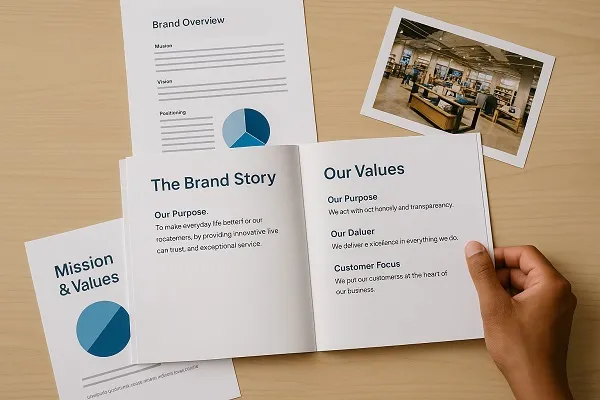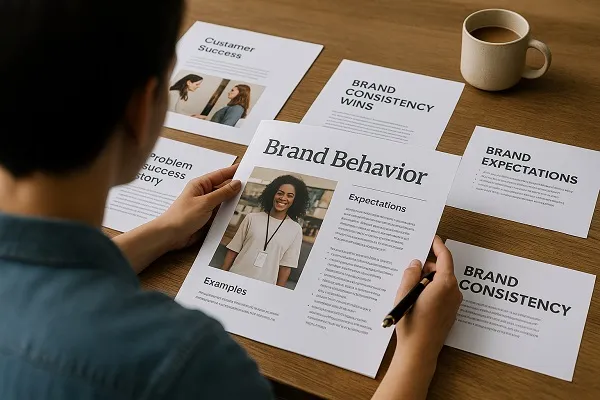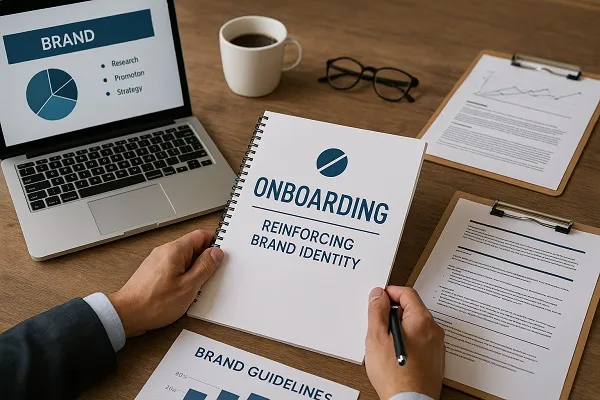How to create onboarding materials that reinforce brand is a priority for companies that want employees to adopt the culture, voice, and values from day one. Strong onboarding content shapes early perceptions, reduces confusion, and helps new hires understand how to represent the brand consistently.
Effective onboarding materials do more than share information. They communicate identity, expectations, and energy. When aligned with brand elements, they give new team members a clear sense of belonging and direction.
Build a Consistent Brand Experience Across All Onboarding Touchpoints
Consistency is one of the strongest ways to reinforce brand identity. Every asset a new hire interacts with should reflect the same look, tone, and intention.
Apply Your Visual Identity Everywhere
Use a cohesive visual system to create familiarity and confidence.
- Brand colors in slide decks, PDFs, and digital platforms
- Approved typography in all written materials
- Logo usage aligned with brand guidelines
- Photography and illustration styles that match your brand aesthetic
Keep the Tone and Voice Aligned
New hires learn how to communicate by observing how the company communicates.
Use the brand voice consistently in:
- Welcome letters
- Training modules
- Internal messaging templates
- Team introductions
Short, clear language strengthens engagement, while a consistent tone reinforces company personality.
Develop Onboarding Materials That Tell a Clear Brand Story

Your brand story should be woven naturally throughout the onboarding experience. Instead of explaining what branding is, focus on how to integrate your story into practical materials employees actually use.
Highlight the Purpose Behind the Brand
Employees connect more deeply when they understand why the brand exists and who it serves.
Use storytelling techniques within:
- The welcome guide
- The brand overview module
- The mission and values booklet
Keep paragraphs brief and easy to scan. Use real examples that show how purpose influences decisions, products, and customer interactions.
Incorporate Real Brand Examples
Authentic examples show how the brand looks and behaves in the real world.
Include:
- Before and after visuals of branded content
- Screenshots of customer interactions that reflect brand tone
- Product or service moments that demonstrate brand principles
These concrete examples help new hires understand expectations quickly.
Create Role Specific Onboarding Content That Supports Brand Consistency
Generic onboarding information can leave new team members guessing about how branding applies to their daily responsibilities. Role specific materials make brand alignment easier to achieve.
Tailor Materials for Customer Facing Roles
Employees who directly represent your brand need clear guidelines.
Provide resources such as:
- Communication templates
- Customer interaction scenarios
- Tone guidance for phone, email, chat, and social
- Do and don’t examples that match brand expectations
Support Internal Teams With Brand Aligned Resources
Even behind the scenes roles impact the brand.
Consider building:
- Workflow guides formatted in brand style
- Documentation templates
- Project brief samples reflecting brand voice
- Design or compliance checklists where relevant
These materials promote consistency across departments.
Use Multimedia Formats to Strengthen Brand Immersion

Different content formats help new employees engage with the brand in diverse ways. Multimedia onboarding keeps the experience dynamic and reinforces brand identity through multiple senses.
Video Introductions and Brand Moments
Video is a powerful medium for showcasing personality, leadership style, and culture.
Consider creating:
- A welcome message recorded by leadership
- A brand identity walkthrough
- Team introduction clips
- Brief scenario videos showing brand aligned behaviors
These videos communicate tone and energy more effectively than text alone.
Interactive Modules and Microlearning
Interactive formats keep employees involved while guiding them through brand aligned content.
Examples include:
- Click through brand guideline tours
- Short quizzes about core values
- Drag and drop exercises for tone matching
- Scenario based learning activities
Interactive learning improves retention while reinforcing key brand elements.
Provide Branded Templates and Tools Employees Can Use Immediately
Practical, ready to use templates help employees execute the brand correctly from day one.
Communication Templates
Offer branded versions of:
- Email signatures
- Messaging templates
- Customer response libraries
- Internal update formats
These give new hires a starting point that prevents off brand communication.
Work and Project Templates
Teams often create documents daily. Branded versions maintain consistency.
Examples include:
- Slide decks
- Reports
- Project outlines
- Meeting notes
- Proposal documents
Templates save time while supporting brand cohesion.
Reinforce Brand Behavior Through Examples and Expectations

Clear directives help new hires understand how to use the brand in real situations. Expectations should be written in accessible language and supported with examples.
Set Clear Brand Behavior Guidelines
Outlining expected behaviors prevents confusion and misalignment.
Focus on:
- How employees should represent the brand in interactions
- How to handle conflicts or challenges while staying aligned with values
- How tone changes in different communication channels
- How brand personality influences decision making
Share Stories That Demonstrate Brand Alignment
Story based examples help employees internalize brand expectations.
Useful story types include:
- Customer success stories
- Team collaboration stories
- Brand consistency wins
- Problem solving examples rooted in brand values
Stories make brand behavior feel real and memorable.
Make Onboarding Materials Easy to Access and Navigate
Even the best onboarding content loses impact if it is hard to find or understand. Make the materials accessible, organized, and intuitive.
Centralize All Onboarding Resources
Place everything in one branded location, such as:
- A digital onboarding hub
- A learning management platform
- A dedicated internal microsite
Organize content by day, theme, or role to reduce overwhelm.
Simplify the Structure
Clear structure reduces cognitive load, especially during the first week.
Use:
- Short sections
- Clean layouts
- Clear labels
- Visual cues that match your brand identity
New hires feel more confident and supported when navigation is simple.
Strengthen Brand Alignment Through Manager Led Onboarding Moments

Managers directly influence how new hires interpret the brand. Support them with brand aligned resources that help guide discussions and expectations.
Provide Managers With Branded Checklists and Talking Points
Managers benefit from:
- A first week checklist
- Discussion prompts tied to brand values
- Role based expectations documents
- Tips for reinforcing brand aligned behavior
Encourage Brand Focused Team Introductions
Team culture sets the tone early.
Encourage teams to:
- Share examples of how they use brand values
- Highlight how their work supports the brand promise
- Discuss communication norms consistent with brand voice
These conversations deepen understanding and build a sense of belonging.
Building onboarding materials that reinforce brand identity ensures employees start with clarity and confidence. When every touchpoint reflects your brand voice, visuals, and values, new hires quickly learn what the brand stands for and how they can contribute. This approach creates alignment, improves communication, and strengthens culture from the very beginning.
Content reviewed and published by Parrot Branding Editorial Team.

